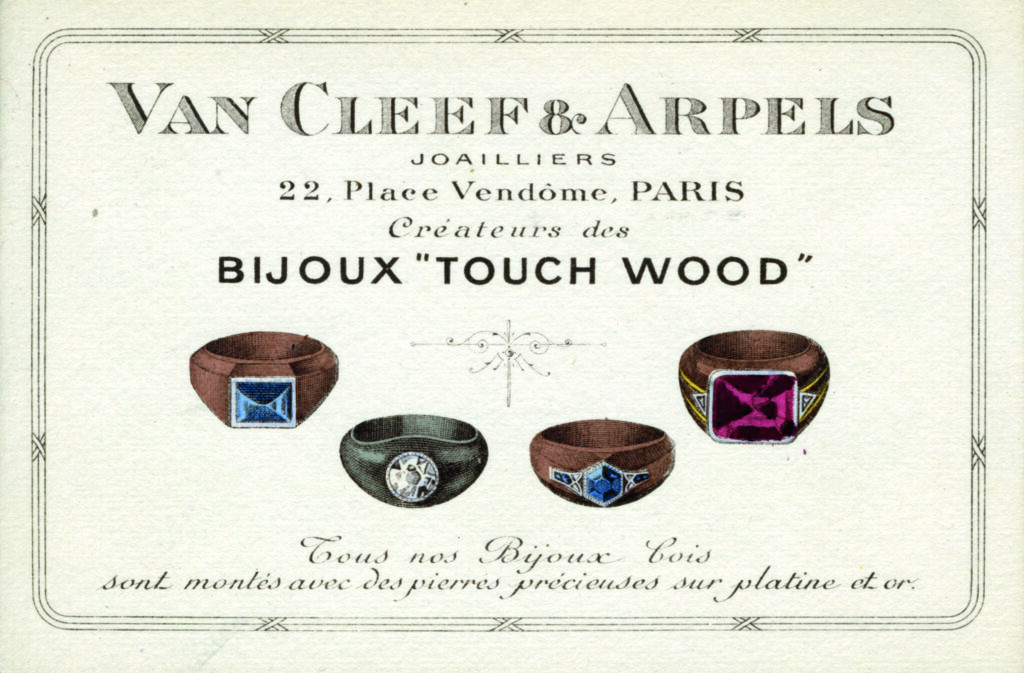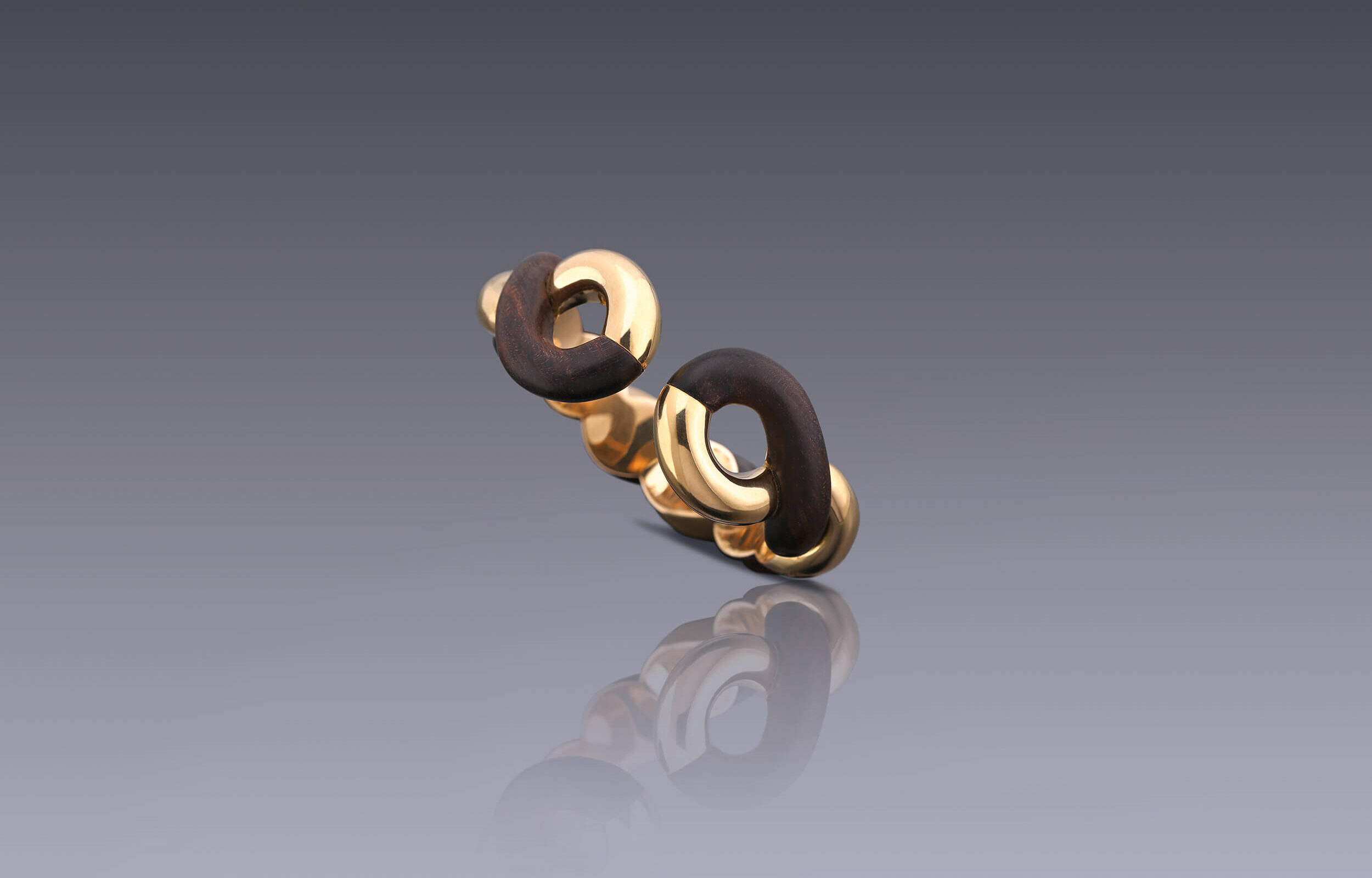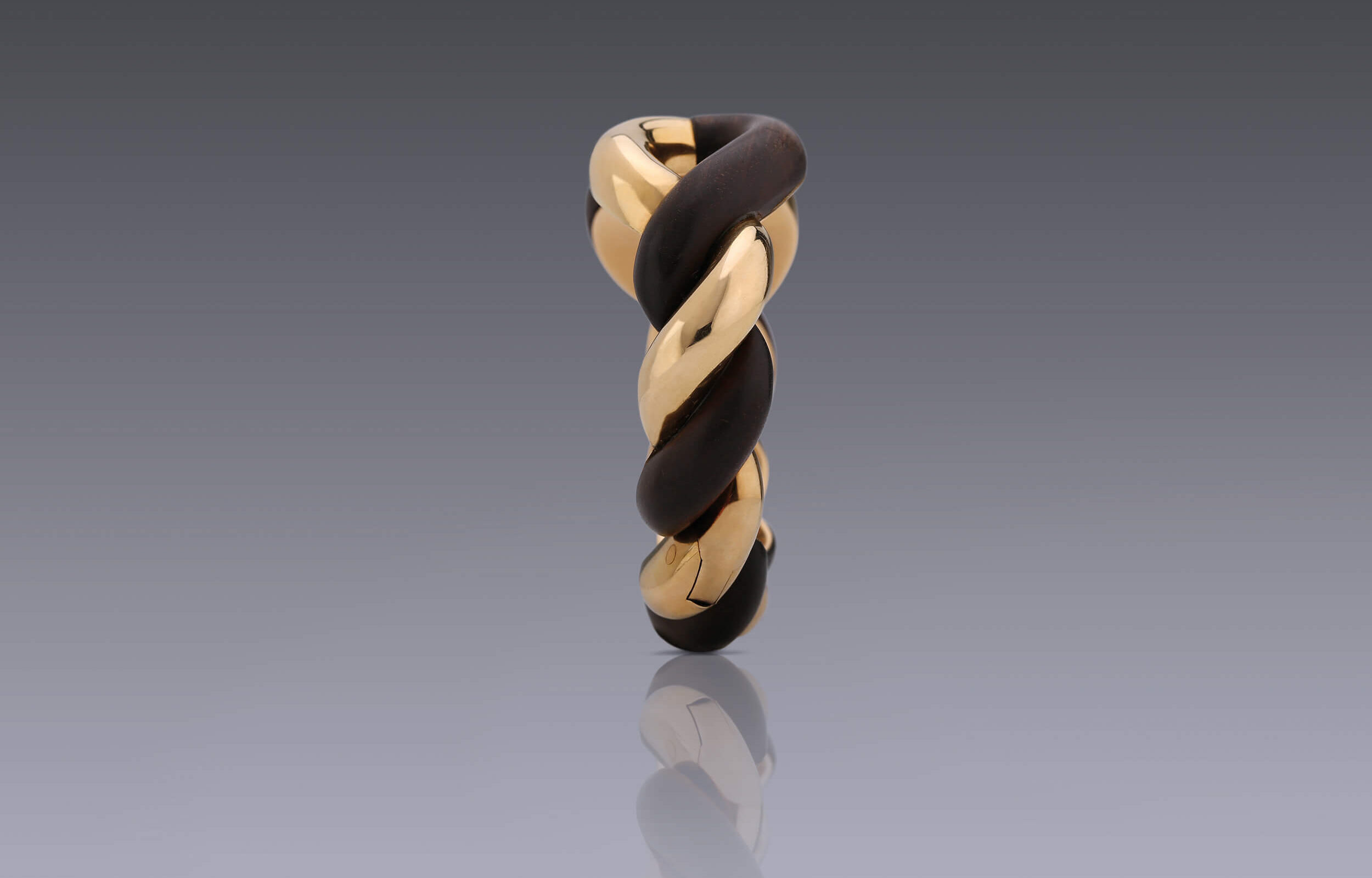This 18-carat gold and wood bracelet was made van Van Cleef & Arpels in Paris around 1970. It is made in the shape of a twisted cable ending in two loops. The two parts of the bracelet are joined on the underside by an concealed gold hinge. This jewel is an extraordinarily powerful nineteen-seventies revival of a line of jewellery designed by Van Cleef & Arpels for the first time in the nineteen-twenties. Luck has always been an important theme for the celebrated jewellery house of Van Cleef & Arpels. Pour avoir de la chance, il faut croire à la chance said Jacques Arpels. To have luck, you must believe in luck. During its time in business, the house has made many luxurious, wearable lucky charms or talismans, of which this beautifully made bracelet is a fine example.
Touch Wood Bracelet
Touch Wood Jewels
Van Cleef and Arpels made the first good luck jewels in which wood was used in the nineteen-twenties with the range 'Touch Wood' jewels. But why did people touch wood for luck? As the jewellery house itself explains, it is said that wood, the tree, is the eternal reservoir of life. In the past people believed that dryads, nymphs, lived in the forest. When you wanted a wish to come true you went into the forest. You touched or knocked on the wood of the tree and asked the nymph to grant your wish.
In Chinese writing the sign for wood can also be interpreted as a symbol of long life and happiness. In this postwar period, the house of Van Cleef and Arpels translated these symbols into special talismans in the form of jewels in which wood was incorporated. By giving these jewels to a loved one you could wish them protection and good luck. The wood used in these jewels had to have a very beautiful, fine grain, so it was often bois d’amourette, also known as letterwood and specklewood, that was used. This was a dark, hard type of wood which, like ebony and amaranth (purpleheart), can be beautifully polished and contrasts well with the gold and gemstones with which it was combined.

Bois d’amourette
In French the wood of the Brosimum guianense Moracceae is called bois d’ amourette, bois de lettre (letterwood) or bois de serpent (snakewood). It is a rare and costly tropical wood from (French) Guyana, Suriname and Brazil and has been highly valued by furniture makers for centuries.
The name letterwood came about in the sixteenth or seventeenth century when Jesuits used the wood to make letter stamps for their manuscripts. It was recognized as a costly material and became, along with sugar, a sought-after means of exchange or payment. A regulation was issued in Suriname in 1670, fixing the parity of 3 pounds of amourette at 2 pounds of sugar. In the seventeenth century Suriname was even labelled Specklewood Country on English maps.
The heartwood has a fine grain, is yellow to reddish-brown in colour and may contain irregular dark stripes running across the grain, which give the wood the appearance of snakeskin. By no means every piece of this wood has this degree of marking. The wood grows slowly, is very hard and heavy and can be finished and polished to make it extremely smooth. Van Cleef & Arpels’s decision to use the term bois d’amourette undoubtedly has to do with its romantic connotation. The name would further be given to the wood because of its deep (brownish) red colour and it would bring good luck.
1970’s
This bracelet was made in the period around 1970, when Van Cleef & Arpels re-introduced the use of wood as a lucky motif. Once again, the theme was a great success. The world becomes another and more magical place if you feel lucky. And that wish is timeless. The nineteen-seventies were seen as the decade of individuality, the hippie movement and disco. Jewels were worn to be seen and to make a statement. There was a demand for unconventional, eye-catching pieces. Natural materials like shell, wood and bone were used for jewellery, and at the top end of the market yellow gold became fashionable. The pieces became more abstract and new shapes made their appearance. The design and the symbolism of this bracelet with the superb dark wood was spot on.
Van Cleef & Arpels
In the nineteenth century, as in the centuries before, marriage was the perfect way to create alliances between families and stimulate strong economic ties. This is what happened when Estelle Arpels, the daughter of a merchant in precious stones fell in love with Alfred van Cleef, the son of an Amsterdam gemcutter. The couple married in 1895. The following year, Alfred set up Maison Van Cleef & Arpels with Estelle’s father Salomon Arpels. After Salomon’s death in 1906, two of his sons joined the firm, and Van Cleef & Arpels opened its first boutique in chic Place Vendôme in Paris. For the first time four-leafed clovers appeared in the archives, followed by a series of jewels depicting wooden talismans, nymphs and ladybirds. Boutiques soon followed in all the fashionable seaside resorts where the Paris beau monde spent the summer months, from Deauville to Monte Carlo.
In 1926, Estelle Arpels and Alfred Van Cleef’s daughter, Renée Rachel Puissant, became the firm’s artistic director. The house had become celebrated for the Mystery Set™ technique developed and patented in 1933, in which gemstones are mounted without a visible setting.
Her brother Julien’s children – Jacques, Claude and Pierre Arpels – became partners in 1937. In 1939, as the Second World War loomed, the family emigrated to America and opened shops in Palm Beach and New York. Since the foundation of the house, the jewels have been fashionable with royal families, film stars and the very wealthiest.
Lasbleiz Fournier Vitiello
This Van Cleef & Arpels bracelet was executed for the house by Lasbleiz Fournier Vitiello, the surnames of three goldsmith friends, who started to work together in 1962. The firm specialized in making extremely high-quality jewels and silver objects, for Van Cleef & Arpels, Hermès, and other major jewellery houses in Paris. The company’s maker’s mark is an amphora.
Signed and numbered , with maker's mark for Lasbleiz, Fournier, Vitiello.
Weight 70 Grams
This site is protected by reCAPTCHA and the Google Privacy Policy and Terms of Service apply.

